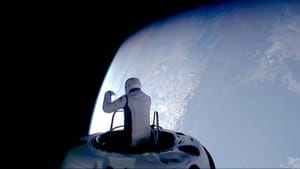
Sep 14, 2024
Polaris Dawn completes first commercial spacewalk!
Back on September 10th, the Polaris Dawn mission lifted off from Launch Complex 39A, in Florida, at 09:23 am, Universal Coordinated Time. The mission is utilizing Crew Dragon C207 'Resilience', which was launched atop of a Falcon 9 with its booster, B1083, flying for the fourth time.
So far the crew of Polaris Dawn has spent four days in orbit, so let's recap ahead of them returning home on September 15th (Universal Coordinated Time).
Day One
The crew's first day in orbit was the beginning of the two-day pre-breathe, ahead of a spacewalk on day three. This pre-breathe has Crew Dragon slowly lower pressure while increasing oxygen levels.
During the first day, the crew also tested the Starlink laser-based connections along with various science experiments. Day one also had Crew Dragon make its first pass through the South Atlantic Anomaly, an area of the Van Allen belt that has more radiation particles closer to Earth.
Day Two
The beginning of the second day in orbit had Crew Dragon reach an apogee of 1,400 kilometers, becoming the highest the spacecraft has traveled as well as the furthest humans have traveled from Earth since the Apollo program. After this Crew Dragon performed a series of burns to manoevur down to an orbit of 190 x 700 kilometers.
Like the previous day, the crew conducted science experiments, this time with a focus on monitoring initial changes to eyesight and ocular health, studying how fluid shifts and exposure to microgravity affect blood flow, and assessing how medications are processed by the body while in orbit.
More tests of Starlink's laser-based connections were performed via video calls to the crews' families as well as a book reading from Crew Dragon to the St. Jude Children's Research Hospital.
Join Polaris Dawn's @annawmenon for an on-orbit reading of her book alongside her family and patients from @StJude ✨
— Polaris (@PolarisProgram) September 12, 2024
Published by Penguin Random House, Kisses from Space was authored by Anna Menon and Keri Vasek and was illustrated by Andy Harkness.
After her book reading,… pic.twitter.com/kSrjgP7Mhx
Polaris Dawn's on-orbit book reading, via PolarisProgram on X.
Day Three
The third day in orbit was the big day with all four crew members donning their spacesuits, having completed a pre-breathe for the past two days.
At 10:15 am, Universal Coordinated Time, on September 12th the 106-minute spacewalk from Crew Dragon began. Mission Commander Jared Isaacman was the first to perform a spacewalk out of the front of the spacecraft. After Isaacman had performed his spacewalk, Mission Specialist Sarah Gillis also exited the front of the spacecraft to perform a spacewalk. Neither were out of Crew Dragon at the same time. Mission Pilot Kidd Poteet and Mission Specialist Anna Menon also remained seated inside Crew Dragon during the spacewalk.
Both spacewalkers performed mobility tests during the spacewalk, as this was the first time a SpaceX-designed suit had been used in the vacuum of space. This was also the first commercial spacewalk performed in almost sixty years of spacewalking.
SpaceX and the Polaris Dawn crew have completed the first commercial spacewalk!
— Polaris (@PolarisProgram) September 12, 2024
“SpaceX, back at home we all have a lot of work to do, but from here, Earth sure looks like a perfect world.” — Mission Commander @rookisaacman during Dragon egress and seeing our planet from ~738 km pic.twitter.com/lRczSv5i4k
Polaris Dawn's Commander Jared Isaacman's spacewalk from Crew Dragon, via PolarisProgram on X.
Day Four
After the spacewalk the day before, the crew spent day four performing science and research experiments. A few of the experiments that have been focused on since launch are the effects of microgravity on the human airway and veinous system, the effects of microgravity on ocular health to help contribute to both preventative and post-diagnosis treatments, as well as a commercial off-the-shelf device that can collect and integrate measurements of health along with ultrasound imaging capabilities.
Polaris Dawn's crew also performed one of the biggest tests for Starlink's laser-based connections by sending a video of Mission Specialist Sarah Gillis playing “Rey’s Theme” by John Williams on the violin back down to Earth.
HARMONY OF RESILIENCE: Recorded in space and sent to Earth via @SpaceX’s @Starlink constellation, Polaris Dawn crewmember and violinist @Gillis_SarahE invites you to enjoy this music moment in support of @StJude & @ElSistemaUSA → https://t.co/My8cUwAWzg pic.twitter.com/OoxTllCZNP
— Polaris (@PolarisProgram) September 13, 2024
Sarah Gillis' performance of "Rey's Theme" synched with orchestras around the world, via PolarisProgram on X.
Who's flying on Polaris Dawn?
The four crew members onboard Crew Dragon C207 'Resilience' are Commander Jared Isaacman, Pilot Scott “Kidd” Poteet, Mission Specialist Anna Menon, and Mission Specialist Sarah Gillis.

Jared Isaacman is the Mission Commander for Polaris Dawn. Isaacman is the only member of the crew to have traveled into orbit before, he previously commanded the Inspiration4 mission in 2021.
Within Earth's atmosphere, Isaacman has over 7,000 hours of flight experience in various experimental and ex-military aircraft. In these aircraft, he has performed two 'speed around the world' flights to raise money for charity, as well as participating in over one hundred airshows.
Scott “Kidd” Poteet is the Mission Pilot for the Polaris Dawn mission. This is his first trip to space.
Poteet is also a retired United States Air Force Lieutenant Colonel who served 20 years in various roles including Commander of the 64th Aggressor Squadron, USAF Thunderbird #4 Demonstration Pilot, USAF Weapons School Graduate, Operational Test & Evaluation Pilot, and Flight Examiner. During his time flying within the atmosphere, Poteet has over 3,200 hours of flight experience in aircraft such as the F-16, A-4, T-38, T-37, T-3, and Alpha Jet.
Sarah Gillis is the Mission Specialist for the Polaris Dawn mission. This is her first trip to space.
Gillis is a Lead Space Operations Engineer at SpaceX, and is responsible for the company's training of NASA and commercial astronauts training with the Crew Dragon spacecraft. On Earth, she has supported operations for cargo resupply missions to and from the International Space Station and as a crew communicator for human spaceflight missions
Anna Menon is the Mission Specialist and Medical Officer for the Polaris Dawn mission. This will is also her first trip to space.
Menon is also a Lead Space Operations Engineer at SpaceX and manages the development of crew operations, as well as working in mission control as both a Mission Director and crew communicator. While at SpaceX, she has been in mission control for the Demo-2, Crew-1, CRS-22, CRS-23, Crew-3, Crew-4, and Axiom-1 missions, while also developing responses to emergencies with Crew Dragon, like depressurization and fires.
What is Crew Dragon?
Crew Dragon, or Dragon 2, is a partially reusable spacecraft developed by SpaceX. The primary use for Crew Dragon is to send crew to and from the International Space Station. SpaceX also performs free-flight missions with the spacecraft.

For the Polaris Dawn mission, Crew Dragon has been modified to support a spacewalk. SpaceX has swapped out the docking port on the front of the vehicle with its 'Skywalker' structure. 'Skywalker' is designed to help the crew exit Crew Dragon, and move back inside after the spacewalk.
Crew Dragon consists of the capsule and trunk. The trunk is used to store unpressurized cargo as well as have solar panels mounted on one side, to generate power, and radiators on the other, to dissipate heat generated inside. The trunk is not reused and burns up in the atmosphere after each mission. The capsule is where the crew will be during launch, landing, and while on their way to space. Unlike the original Dragon capsule, the Crew Dragon capsule has a launch abort system consisting of eight SuperDraco engines. The capsule also has a nosecone that will fold out of the way in space to protect the docking hardware and forward-facing thrusters during launch and landing. The forward-facing thrusters are the main propulsion system for performing maneuvers while in flight.
Crew Dragon was developed as part of NASA's Commercial Crew Program to regain crew access to the International Space Station from the United States of America after the retirement of the Space Shuttle. SpaceX currently has four active Crew Dragon capsules; Endeavour, Resilience, Endurance, and Freedom. A fifth Crew Dragon capsule is under construction and is expected to be finished in 2024.



